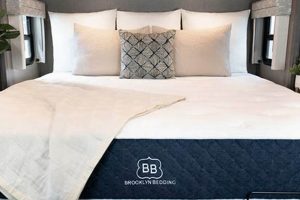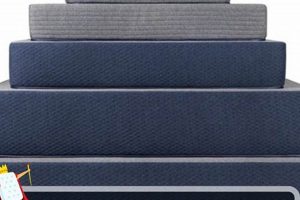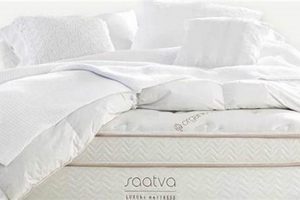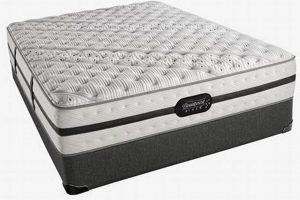The optimal sleep surface for individuals experiencing back discomfort is a crucial consideration in promoting spinal alignment and alleviating pressure points. Selecting a sleep system that addresses individual needs can be instrumental in achieving restorative rest and minimizing morning pain.
A properly designed sleep surface can significantly improve sleep quality and reduce chronic back pain. Historically, advancements in material science and ergonomic research have led to the development of mattresses that offer improved support and pressure relief. This evolution underscores the growing understanding of the relationship between sleep posture and musculoskeletal health.
Therefore, a comprehensive exploration of mattress types, support structures, and material properties is warranted to determine the factors that contribute to a sleep surface conducive to back pain relief and improved spinal health.
Guidance for Selecting an Appropriate Sleep Surface
Choosing a mattress that alleviates back discomfort requires careful consideration of several key factors. The following guidance aims to inform decision-making and improve the likelihood of selecting a sleep surface that promotes spinal health.
Tip 1: Prioritize Spinal Alignment: The chosen sleep surface must maintain the natural curvature of the spine. A mattress that is too soft may allow the spine to sag, while one that is too firm may create pressure points. Evaluate support in various sleep positions.
Tip 2: Consider Material Composition: Different materials offer varying degrees of support and pressure relief. Memory foam conforms to the body, potentially reducing pressure points. Latex offers a more responsive and supportive feel. Innerspring mattresses provide traditional support, but may require a comfort layer for optimal pressure relief.
Tip 3: Evaluate Firmness Level: Firmness is subjective, but individuals with back pain often benefit from a medium-firm mattress. This level of firmness provides adequate support while still allowing for some contouring to the body.
Tip 4: Assess Edge Support: Strong edge support prevents roll-off and provides a stable surface for getting in and out of bed. This is particularly important for individuals with mobility issues or those who share the bed.
Tip 5: Consider Individual Sleep Position: Side sleepers typically require a softer mattress to accommodate the shoulders and hips, while back sleepers generally benefit from a firmer surface to maintain spinal alignment. Stomach sleeping is often discouraged due to its potential to exacerbate back pain.
Tip 6: Research Trial Periods and Warranties: Many mattress manufacturers offer trial periods, allowing individuals to test the mattress for a specified time and return it if it is not suitable. A comprehensive warranty provides assurance against defects and premature wear.
Tip 7: Consult with Healthcare Professionals: Seek guidance from a physician or physical therapist to determine the most appropriate mattress type and firmness level based on individual spinal conditions and pain points.
Selecting a mattress that effectively addresses back pain requires a holistic approach, considering individual needs, preferences, and medical recommendations. Adhering to these guidelines increases the likelihood of choosing a sleep surface that promotes spinal health and improves sleep quality.
The subsequent sections will delve into specific mattress types and their suitability for addressing different back pain conditions.
1. Spinal Alignment
Spinal alignment constitutes a primary determinant in the selection of an appropriate sleep surface for individuals experiencing back pain. An improper sleep surface can exacerbate existing conditions or contribute to the development of musculoskeletal issues. A mattress failing to maintain the spine’s natural curves may induce muscle strain as the body attempts to compensate for inadequate support. For example, a mattress with excessive give may allow the pelvis to sink, resulting in lumbar hyperextension, a common cause of lower back pain. Conversely, a surface that is too firm may fail to conform to the body’s contours, leading to pressure points along the spine.
The effectiveness of a mattress in promoting spinal alignment can be objectively assessed through various methods. Clinical studies employing pressure mapping and motion capture technology have demonstrated the correlation between mattress type and spinal posture during sleep. Furthermore, subjective reports from individuals experiencing back pain consistently highlight the importance of a supportive sleep surface in alleviating discomfort and improving overall sleep quality. Selecting a mattress is not merely about personal preference but rather a biomechanical consideration. A sleep surface with adjustable lumbar support, for example, provides a more targeted approach to maintaining alignment, catering to the specific needs of individuals with varying spinal conditions.
In summary, the concept of spinal alignment is central to understanding the efficacy of a mattress in mitigating back pain. Addressing spinal support effectively involves careful consideration of firmness, material properties, and individual sleeping positions. The practical significance of prioritizing spinal alignment in mattress selection cannot be overstated, as it directly influences the long-term health and well-being of individuals with back conditions.
2. Pressure Relief
Pressure relief is a fundamental characteristic in determining the suitability of a mattress for individuals experiencing back discomfort. The capacity of a sleep surface to redistribute body weight and minimize concentrated stress on specific areas is crucial for alleviating pain and promoting restorative sleep.
- Conformability of Materials
Mattress materials exhibiting high conformability, such as memory foam or latex, can effectively contour to the body’s shape. This conforming action distributes weight more evenly, reducing pressure points that can exacerbate back pain. For example, a memory foam mattress will mold to the sleeper’s body, cradling pressure-sensitive areas like the shoulders and hips, thereby reducing stress on the spine.
- Impact on Spinal Alignment
Pressure relief directly impacts spinal alignment. By minimizing pressure points, a mattress allows the spine to maintain its natural curvature. When pressure is concentrated in certain areas, the spine may be forced into an unnatural position, contributing to muscle strain and discomfort. An appropriate level of pressure relief facilitates a neutral spinal posture, reducing strain on supporting muscles and ligaments.
- Influence on Circulation
Excessive pressure on bony prominences can impede blood circulat
ion. This reduced circulation can lead to muscle stiffness and pain. A mattress that effectively relieves pressure allows for improved blood flow throughout the body, promoting muscle relaxation and reducing the likelihood of pain arising from circulatory restrictions. Individuals with pre-existing circulatory issues often benefit from mattresses designed for superior pressure relief. - Role in Sleep Quality
Discomfort caused by pressure points can disrupt sleep patterns, leading to fragmented and non-restorative sleep. By mitigating these pressure points, a mattress enhances overall sleep quality. Improved sleep quality is linked to reduced pain perception and improved physical function, highlighting the importance of pressure relief in managing back discomfort.
The effectiveness of pressure relief is integral to optimizing the sleep environment for individuals seeking to alleviate back pain. The material composition, design, and firmness of a mattress must be carefully considered to ensure that it provides adequate pressure relief, thereby promoting spinal alignment, improving circulation, and ultimately, enhancing sleep quality and reducing pain.
3. Support System
The internal support architecture of a mattress plays a critical role in determining its suitability for individuals seeking relief from back pain. The support system influences spinal alignment, pressure distribution, and overall durability, all of which contribute to the long-term comfort and therapeutic efficacy of the sleep surface.
- Innerspring Coil Systems
Innerspring mattresses utilize a network of metal coils to provide support. The gauge, density, and configuration of these coils directly impact the firmness and responsiveness of the mattress. Individually wrapped or pocketed coils mitigate motion transfer and contour to the body more effectively than interconnected coil systems. A mattress with inadequate coil support may lead to spinal misalignment and increased back pain.
- Foam Core Construction
Foam core mattresses rely on layers of high-density foam, such as polyurethane or memory foam, to provide support. The density and thickness of these foam layers determine the level of firmness and the ability to distribute weight evenly. High-density foam cores offer greater durability and resistance to sagging compared to lower-density alternatives, preserving spinal alignment over time.
- Hybrid Support Structures
Hybrid mattresses combine innerspring coil systems with layers of foam, offering a balance of support and comfort. The coil system provides a stable foundation, while the foam layers offer pressure relief and contouring. The efficacy of a hybrid mattress depends on the quality and arrangement of both the coils and foam, with well-designed hybrids offering enhanced spinal support and reduced back pain.
- Adjustable Base Compatibility
The compatibility of a mattress with an adjustable base can significantly enhance its therapeutic benefits. Adjustable bases allow for customized positioning, such as elevation of the head and legs, which can alleviate pressure on the spine and improve circulation. A mattress designed to articulate smoothly with an adjustable base ensures optimal support and pressure relief in various sleeping positions.
The selection of a mattress with an appropriate support system is paramount for individuals experiencing back pain. The ideal support structure should maintain spinal alignment, distribute weight evenly, and offer long-term durability. Consideration of coil systems, foam cores, hybrid designs, and adjustable base compatibility contributes to informed decision-making and promotes a sleep environment conducive to back pain relief.
4. Material Density
Material density within a mattress significantly influences its ability to provide adequate support and pressure relief for individuals with back pain. The density of foam or other materials directly affects durability, contouring ability, and the overall effectiveness of the sleep surface.
- Support and Spinal Alignment
Higher density materials provide superior support, preventing excessive sinking and maintaining proper spinal alignment. Insufficient density can result in the spine sagging, exacerbating back pain. For instance, a high-density memory foam mattress is more likely to maintain its shape and provide consistent support compared to a low-density counterpart, reducing the risk of spinal misalignment.
- Pressure Relief Distribution
Material density influences how effectively a mattress distributes pressure. Denser materials tend to spread weight more evenly, minimizing pressure points that can contribute to back discomfort. Consider a latex mattress; higher density latex offers enhanced pressure relief by conforming to the body’s contours while maintaining consistent support, reducing concentrated pressure on sensitive areas of the back.
- Durability and Longevity
Density directly correlates with the lifespan of a mattress. Higher density materials resist compression and wear over time, maintaining their supportive properties for a longer period. A high-density foam mattress is less likely to develop indentations or sagging, preserving its ability to provide optimal support and pressure relief for an extended duration.
- Motion Isolation Properties
Denser materials often exhibit superior motion isolation, minimizing the transfer of movement across the mattress. This is particularly beneficial for individuals sharing a bed, as it reduces disturbances caused by a partner’s movements, allowing for more restful sleep and minimizing exacerbation of back pain.
In summary, material density is a critical factor in the selection of a mattress designed to alleviate back pain. High-density materials offer improved support, pressure relief, durability, and motion isolation, all of which contribute to a more comfortable and therapeutic sleep environment for individuals with back conditions.
5. Firmness Level
Firmness level is a significant determinant in selecting a mattress suitable for individuals experiencing back discomfort. The perception of firmness is subjective; however, its objective impact on spinal alignment and pressure distribution is crucial in alleviating pain and promoting restorative sleep.
- Impact on Spinal Alignment
Mattress firmness directly influences spinal curvature during sleep. A surface that is too soft may allow the spine to sag, leading to muscle strain and discomfort. Conversely, a surface that is too firm may not conform adequately to the body’s contours, resulting in pressure points and restricted blood flow. The optimal firmness level supports the spine’s natural alignment, minimizing stress on muscles and ligaments.
- Pressure Point Mitigation
Appropriate firmness is essential for distributing body weight and reducing pressure points. A mattress with inadequate firmness may concentrate pressure on bony prominences, such as t
he hips and shoulders, causing pain and disrupting sleep. A mattress with optimal firmness allows for even weight distribution, minimizing pressure on these sensitive areas and promoting circulation. - Consideration of Sleeping Position
Sleeping position influences the ideal firmness level. Side sleepers typically require a softer mattress to accommodate the curvature of the spine and prevent pressure on the shoulders and hips. Back sleepers generally benefit from a medium-firm mattress that provides adequate support while maintaining spinal alignment. Stomach sleeping is often discouraged but, if unavoidable, may necessitate a firmer mattress to prevent excessive spinal curvature.
- Firmness Scale and Individual Preference
Mattress firmness is often rated on a scale, typically ranging from 1 (very soft) to 10 (very firm). However, individual perception of firmness can vary based on body weight, sleeping position, and personal preferences. It is advisable to test mattresses with varying firmness levels to determine the most suitable option for individual needs. Trial periods offered by many mattress retailers allow for in-home assessment of firmness and comfort.
In summary, firmness level is a key consideration in choosing a mattress conducive to back pain relief. The ideal firmness supports spinal alignment, mitigates pressure points, and accommodates individual sleeping positions and preferences. Careful evaluation and testing are essential to determining the firmness level that promotes optimal comfort and reduces back discomfort.
6. Motion Isolation
Motion isolation, the capacity of a mattress to minimize the transfer of movement across its surface, is a significant attribute, especially when evaluating options conducive to back pain relief. Disrupted sleep cycles stemming from partner movement can exacerbate existing back conditions. A sleep surface exhibiting poor motion isolation may transmit disturbances, such as tossing and turning, leading to increased muscle tension and subsequent pain. A mattress with enhanced motion isolation, conversely, dampens these movements, allowing for uninterrupted sleep. This is particularly relevant for individuals whose back pain is sensitive to movement or who share a bed with a restless sleeper.
The relationship between motion isolation and back pain management can be exemplified by contrasting different mattress types. Innerspring mattresses, particularly those with interconnected coils, typically exhibit limited motion isolation, potentially transferring movement widely across the surface. In contrast, memory foam and pocketed coil mattresses often demonstrate superior motion isolation. The memory foam’s viscoelastic properties absorb motion, while pocketed coils allow independent compression, reducing disturbance. This difference directly impacts sleep quality and subsequent back pain levels. Couples who have switched from an innerspring to a memory foam or pocketed coil mattress frequently report reduced sleep disturbances and an improvement in their individual pain management.
In conclusion, motion isolation is a critical factor when considering the selection of a mattress intended to alleviate back pain. A mattress’s ability to minimize motion transfer directly influences sleep quality, muscle relaxation, and the overall experience of back discomfort. The practical significance of this understanding lies in the ability to make informed decisions, prioritizing mattresses with enhanced motion isolation properties, especially when sharing a bed. These mattresses contribute to a more stable sleep environment, mitigating pain and promoting restorative rest.
Frequently Asked Questions
The following addresses common inquiries regarding mattresses designed to alleviate back discomfort.
Question 1: What mattress firmness level is generally recommended for individuals with back pain?
A medium-firm mattress is often suggested. However, the ideal firmness varies based on individual sleeping position, body weight, and specific spinal condition. Consulting with a healthcare professional is advisable to determine the most appropriate level of support.
Question 2: Can a mattress exacerbate existing back problems?
Yes, an unsuitable mattress can worsen back pain. A mattress that lacks adequate support can lead to spinal misalignment, increasing stress on muscles and ligaments. Similarly, a mattress that is too firm may create pressure points, contributing to discomfort.
Question 3: Are memory foam mattresses beneficial for individuals with back pain?
Memory foam can provide pressure relief and contouring, potentially reducing back pain. The material’s ability to conform to the body’s shape distributes weight evenly, minimizing stress on specific areas. However, the density and firmness of the memory foam must be appropriate to ensure adequate support.
Question 4: How important is spinal alignment in the context of mattress selection?
Spinal alignment is paramount. The chosen sleep surface should maintain the natural curvature of the spine, preventing excessive strain on supporting muscles. A mattress that fails to provide proper spinal support can contribute to chronic back pain and musculoskeletal issues.
Question 5: What role does motion isolation play in mattress selection for individuals with back pain?
Motion isolation is particularly important for couples sharing a bed. A mattress with good motion isolation minimizes the transfer of movement, allowing for uninterrupted sleep. Disruptions caused by a partner’s tossing and turning can exacerbate back pain and impede restorative rest.
Question 6: Is there a universally “best” mattress type for all individuals experiencing back pain?
No, there is no one-size-fits-all solution. The optimal mattress type depends on individual factors, including sleeping position, body weight, spinal condition, and personal preferences. A thorough assessment of these factors, coupled with professional guidance, is essential for selecting a suitable sleep surface.
Selecting the correct sleep surface plays a vital role in maintaining long-term spinal health.
The subsequent section will explore strategies for maintaining a sleep environment conducive to back health.
Conclusion
The preceding exploration of the “best mattress for bad back” underscores the multifaceted nature of selecting a sleep surface conducive to spinal health. Key considerations include spinal alignment, pressure relief, support systems, material density, firmness levels, and motion isolation capabilities. Each element contributes uniquely to the overall therapeutic effectiveness of a mattress in mitigating back discomfort and promoting restorative sleep.
The significance of informed decision-making in mattress selection cannot be overstated. A mattress represents a long-term investment in well-being, with direct implications for spinal health and quality of life. Therefore, a proactive approach, involving thorough research, consideration of individual needs, and consultation with healthcare professionals, is essential in securing a sleep environment that supports both physical comfort and long-term musculoskeletal health.



![Top Rated Best Wyoming King Mattress [Review] Organic & Natural Mattress Buyer’s Guide: Non-Toxic Sleep Solutions Top Rated Best Wyoming King Mattress [Review] | Organic & Natural Mattress Buyer’s Guide: Non-Toxic Sleep Solutions](https://mattressworldpa.com/wp-content/uploads/2025/07/th-7657-300x200.jpg)



